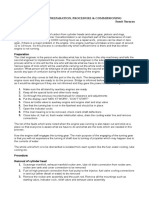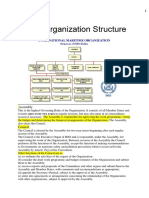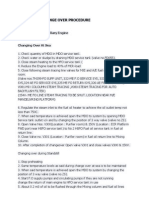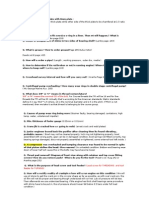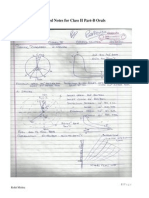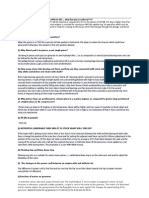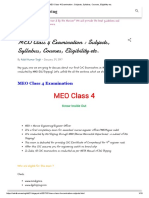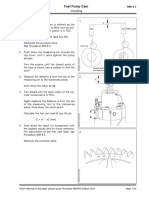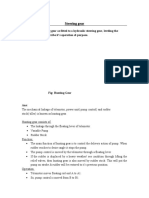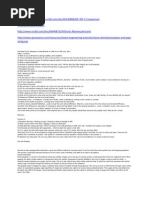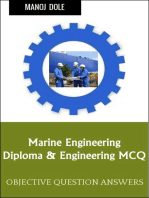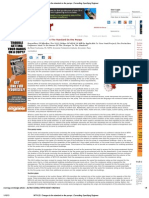MEO Class 2 Orals Safety Q & A
MEO Class 2 Orals Safety Q & A
Uploaded by
neeraj1185Copyright:
Available Formats
MEO Class 2 Orals Safety Q & A
MEO Class 2 Orals Safety Q & A
Uploaded by
neeraj1185Copyright
Available Formats
Share this document
Did you find this document useful?
Is this content inappropriate?
Copyright:
Available Formats
MEO Class 2 Orals Safety Q & A
MEO Class 2 Orals Safety Q & A
Uploaded by
neeraj1185Copyright:
Available Formats
SAFETY ORAL QUESTIONS AND ANSWERS
Q. Major non conformity example and definition. As per ISM code major non conformity means an identifiable deviation that poses a serious threat to the safety of personnel, the ship, or a serious risk to the environment, that requires immediate corrective action. In addition lack of effective and systematic implementation of ISM code is also considered as a major non conformity. Structural damages, Invalid certificates or documents Emergency generator cannot start Oil record book not available Non conformities raised during last internal audits are still pending Non conformity example and definition Means an observed situation, where objective evidence, indicates the non fulfilment of a specified requirement, ISM checklists incomplete, Crew not aware of companies ISM safety and environmental protection policy Responsible officers not knowing their duties as per SMS manual Crew not knowing DPA Oil record book incomplete/ not signed 4. SOLAS latest developments / amendments.
Dec 2004 Amendments,
Bulk carrier safety- A new text for SOLAS chapter XII, Free fall life boat on bulk carrier Simplified VDR, S-VDR May 2005 Amendments, A revised chapter II indented to harmonize the provision on sub division and damaged stability for passenger and cargo ship. Probabilistic method is being used rather than deterministic method. All ships to be provided with arrangements, equipments, fitting of sufficient SWL for safe conduct of towing and mooring Water level detector in cargo holds for new single hold cargo ship other than bulk carrier. Ship construction drawings to be maintained on board and ashore Mandatory company and registered owner identification number May 2006 Amendments Long range identification and tracking system (LRIT) EPIRB capable of transmitting a distress alert through polar orbiting satellite 6. Name a detainable deficiency with respect to SOLAS, LOADLINE, MARPOL, STCW, ILO SOLAS: Improper Design of bilge pumping arrangement, Defect in propulsion and electrical machinery. Failure of proper operation of emergency generator, lighting, batteries , Failure of proper operation of main and aux steering gear, Emergency steering not operational, Certificates under convention expired, Major structural damage not informed to class or flag state. Life boat lowering arrangement not operational. Radio failure for distress signals, Below manning MARPOL Oil record book not available , Failure of operation of IOPP equipments such as OWS, Incinerator. Inadequate tank retention capacity for sludge tank for intended voyage. Sewage plant not operational. Illegal or evidence of illegal connections for bilge pumping. Absence of P &A manual, Cargo record book ILO Inadequate food and water for intended voyage. Sea fearer of age below min specified 15yrs. Evidence of inadequate rest hours STCW Failure of seafarers to hold a certificate, to have an appropriate certificate, to have a valid dispensation or to provide documentary proof that an application for an endorsement has been submitted to the flag State administration. Failure to provide proof of professional proficiency for the duties assigned to seafarers for the safety of the ship and the prevention of pollution. The Load Lines Convention Significant areas of damage, corrosion, or pitting of plating and associated stiffening in decks and hull are noticed affecting seaworthiness and strength. If temporary repairs are done to take local loads and are unless proper temporary repairs for a voyage to a port for permanent repairs have been carried out.
Absence of inability to read draught markings Insufficient stability Overloading
11. What is latest in fire fighting? Water mist nozzles- hyper mist pump and nozzles in engine room, Novec 12. What is MS act? This is a comprehensive piece of legislation passed by Indian parliament in 1958 for development of maritime activities. Merchant shipping act 1958 has been modified many times to implement the provisions of international conventions. 13. Latest developments in tankers /MARPOL Double hull construction, Alternate design of cargo tanks CAS requirement for tankers of 15 year or more Enhanced Survey file to be maintained. 14. Certificates of chemical tanker Fitness certificate for carriage of noxious liquid substances in bulk ( NLS Certificate) 15. M/E breakdown in rough weather. Possibility of cutting out the affected unit Cut out the unit as per makers instructions cut out the fuel pump and exhaust valve using cutting out arrangements- levers for SULZER exhaust valve must be closed . Possibility of repairing or renewal of major spare parts Plan the job check availability of the spares .Prepare to stop engine , let it cool down and start maintenance job. Take full assistance from engine and deck crew. Lash the heavy parts properly. Tell all crew to keep clear and themselves in safe working locations. All must wear full protective gear, should work carefully. Leader to communicate with all. Delegate nature duties and explain them in a meeting prior to starting the work .
Instructions to crew in safeties in dry dock. Look out for any unsafe act Fire capabilities may be reduced and efficient fire patrol to be done Dangers of fall, Protect any open removed guard rails. 18. What is NOx technical file? File maintained on board to verify the various components installed on the engine which affect the engine performance wrt NOx emission. All components replaced and maintenance carried out on these components are to be recorded in this file. There is one file for each engine with EIAPP certificate issues. When replacing these components it is to be checked that the component replaced have the same IMO number as specified in the technical file 19. Latest developments and amendments in bulk carriers. Dec 2004 Amendments : A new text for SOLAS chapter XII Additional safety measures for bulk carrier . New reg 14 on restriction of sailing with one hold empty and requirements for double side skin construction. Free fall life boats made mandatory on bulk carriers. Q. What is continuous synopsis record? SOLAS chapter XI -1 Special measures to enhance maritime safety, Reg 5 states that every ship to which chapter 1 applies shall be issued with a continuous synopsis record . indented to provide on board record of the ship history. Name of flag state , Date registered , Ship identification Number , Name , Port at which registered , Name of owners and address./ If bare boat charterer--their address. Address of safety management company. Name of Class society ,Name of administration issuing SMC,ISSP certificate. Any changes to owner/ Flag state etc to be entered in this record. Q. Ship out of dry-dock, heavy vibrations what internal checks you will carry out. Check the tightness of the foundation bolts of M/E, check the foundation for any damage and tightness of the pedestal bearing , take the engine crankshaft deflection , check the tightness of the shafting couplings , Take the trust bearing clearance. M/E top bracing to be checked , Tie rod tightness to be checked , Check integrity of vibration dampers and detuners if any.
Q. Ship out of dry-dock , SFOC is increased what all-internal checks to carry out? Take indicator cards, Check that power developed are comparable , Incorrect or clogged flow meter, clean the filter , Fuel injection valves may be leaking , Check and compare scavenge air pressure with test trials, Air pressure drop at air filters coolers and assess the need for any cleaning of air side of air cooler. Check the fuel timing .Check the chain tightness.Check the operation of VIT and confirm that linkages are free Q. As 2/E what will you do in annex VI? Keep a accurate record of Ozone depleting substances and if any maintenance work need to be done on A/C or REF plants , methods for extracting Freon from the system to be available. During bunkering a representative sample is obtained with Bunker delivery note with appropriate information to be available. Sample (MARPOL) to be signed and kept on board for 12 months with record. Fuel change over procedure to be available and are followed when required. Records of change over to LSFO consumption and
back is recorded with location. Nox technical file for each engine is available and maintained. Q. What all certificates to carry regarding CO2 system Weight certificate, Pressure test certificates of bottles, lines, Installation cert. Annual shore service certificate
Q. Propeller is to be changed , what will be the role of Second engineer? Give details of the propeller to the company from the makers instructions since it is a dry-dock job and company would arranging for an emergency dry- dock , second eng. must ensure that if any other jobs are to be done. Keep record of fuel consumption and engine power output for future reference. Keep a record of stern tube oil seal leaks if any. Take crankshaft deflection .Instruct the ships crew to give required assistance to dry dock authorities .Keep poker gauge handy and witness the propeller drop when measured by the dry dock authorities .Keep the drawings concerned ready. Check the record of the dynamic balancing of the new propeller .Check the manufacturers details of the new propeller and compare it with old propeller. Details such as- diameter, material , pitch. Ensure that the rope guard is fitted back if removed .Keep no 1 unit on TDC when advised by the dock authorities. Check the mating ( Bedding) surfaces for area of contact- should be more than 90% Ensure that the tallow grease is adequately filled up in the cover and cover is cemented smoothly after boxing up DYNAMIC WINCH BRAKE TEST Annual operational testing should preferably be done by lowering the empty boat. When the boat has reached its maximum lowering speed and before boat enters the water, the brake should be abruptly applied. Five-yearly operational testing should be done by lowering the boat loaded to a proof load of 1.1 times the maximum working load of the winch, or equivalent load. When the boat has reached its maximum lowering speed and before the boat enters the water, the brake should be abruptly applied. Should stop within 1 m of descent. OVERHAUL OF ON-LOAD RELEASE GEAR dismantling of hook release units; examination with regard to tolerances and design requirements; adjustment of release gear system after assembly; operational test as per above and with a load according to SOLAS regulation III/20.11.2.3; and Examination of vital parts with regard to defects and cracks.
Q. Test of fire fighting equipments. Fire Fighting Equipments including portable fire extinguishers that exists while the ship is being registered under Indian flag are required to have documentary evidence of having approval of Administration or classification society, who is a member of the IACS and the fire fighting equipment is approved in accordance with the relevant provision of the SOLAS 74 as amended and relevant provision of the FSS Code and applicable IMO Assembly Resolution All fire extinguishers are required to have 100 % spare charges; Shipping companies are required to ensure that the refill of the same make is available on board ship Shipping companies are not able to comply with the requirement of getting one third of the fire extinguishers pressure tested every year. In order to facilitate shipping companies, it has been decided that fire extinguishers may be hydraulically pressure tested during the dry dock once in three years. However, shipping companies are required to ensure that the ships fire extinguishers are properly maintained and kept in satisfactory operating condition at all times Weekly testing and inspections All public address systems and general alarm systems are functioning properly; and Breathing apparatus cylinders do not present leakages. Monthly testing and inspections all firemans outfits, fire extinguishers, fire hydrants, hose and nozzles are in place, properly arranged, and are in proper condition; all fixed fire-fighting system stop valves are in the proper open or closed position, dry pipe sprinkler systems have appropriate pressures as indicated by gauges; sprinkler system pressure tanks have correct levels of water as indicated by glass gauges; all sprinkler system pumps automatically operate on reduction of pressure in the systems; all fire pumps are operated; and all fixed fire-extinguishing installation using extinguishing gas are free from leakage. Quarterly testing and inspections All automatic alarms for the sprinkler system are tested using the test valves for each section; the international shore connection is in proper condition; lockers providing storage for fire-fighting equipment contain proper inventory and equipment is in-proper condition; all fire doors and fire dampers are tested for local operation; and all CO2 bottle connections for cable operating system clips should be checked for tightness on fixed fire-extinguishing installations. Annual testing and inspections all fire extinguishers are checked for proper location, charging pressure and condition; fire detection systems are tested for proper operation, as appropriate; all fire doors and dampers are tested for remote operation; all foam-water and water-spray fixed fire-fighting systems are tested for operation; all accessible components of fixed fire-fighting system are visually inspected for proper condition; all fire pumps, including sprinkler system pumps, are flow tested for proper pressures and
flows; all hydrants are tested for operation; all antifreeze systems are tested for proper solution; sprinkler system connections from the ships fire main are tested for operation. all fire hoses are hydrostatically tested; breathing apparatus air recharging systems checked for air quality; control valves of fixed fire-fighting system should be inspected; and air should be blown through the piping of extinguishing gas systems. Five-year service hydrostatic testing for all SCBA cylinders; and control valves of fixed fire- fighting systems should be internally inspected. Q. Purpose of VDR and SVDR The purpose of a Voyage Data Recorder (VDR) and Simplified Voyage Data Recorder (S-VDR) is to maintain and store (in a secure and retrievable form) information concerning the position, movement, physical status, command and control of a vessel over the period leading upto and following an incident / casualty. The information contained in the VDR / S-VDR is to be retrieved and used during the subsequent investigation. For a vessel operating in shallow waters, cost of recovery of fixed VDR recording medium may not be very expensive. However, in case a vessel is lost in deep waters, the cost of recovery of the recording medium may be prohibitive and at times not feasible at all. In view of the foregoing, it has been decided that all Indian ships shall install the float-free variety of the VDR / S-VDR. However, if the shipowner has already installed the fixed type of VDR or it is not possible to install the float-free VDR meeting full requirements of the IMO Resolution, they shall ensure that an additional float-free arrangement may be made to retrieve the following information: Q. What is SSAS? The SSAS should be documented in the Ship Security Plan. The location of activation points should be specified in the plan and may form a part of the Confidential Section of the plan. It is advised that such information shall be known to the Master, Ship Security Officer and other ship personnel as may be decided by the Master and the SSO. The dedicated equipment used for transmission of Security Alert should not be used for any other routine communication. The system should have the main source of electrical power and a backup source, which may include emergency source or independent supply. However, an uninterruptible power supply (UPS) or such similar device may also be considered as an alternate source of power. All Indian Ship owners, Company Security Officers, Masters and others concerned may please note that the SSAS test is to be carried out in the "LIVE" mode only. Q. How to test SSAS? The standard procedure for testing of Ship Security Alert System is as follows: 1. E-mail DG Communication centre the following information at least three hours in advance when requesting for a test : a) Name of the vessel and its present position b) Intended date and time (UTC) and IST of the test. 2. The DG Communication centre will acknowledge confirming the conduct of the test. It may be noted that SSAS tests with other ship/s may have already been scheduled at the proposed time, in which case, the DG Communication centre would advise the earliest suitable time for the conduct of the test. 3. The ship staff may then carry out the SSAS test as per schedule, first from Location 1. 4. The CSO/ Master shall confirm by phone whether the Alert has been received by DG Communication centre DG Communication centre will then advise if all details provided in the alert are correct, or otherwise. 5. If all details received are correct, DG Communication centre will advise to reset the alert and then proceed to test from Location 2 6. When testing from Location 2, WAIT FOR about 30 minutes for alert to go to Level 3. 7. Call DG Communication centre to confirm whether alert Level 3 has been received. 8. DG Communication centre will confirm whether all is OK, or otherwise. If all is OK, DG Communication centre will advise the CSO/ Master to reset the system. 9. After resetting the system, the CSO/ Master to send an email to DG Communication centre stating that the "SSAS test has been completed and all subsequent alerts may be treated as true alerts." Request for compliance may be made immediately upon satisfactory completion of the test, and not after several days, 10. DG Communication centre will then revert compliance by email if tests were OK or advise further testing/ rectification, as required.
Q. Requirements of a UMS ship as per SOLAS? Fire Protection: 1. Fire Detection & Alarm systems in: a) Boiler Air supply casings & exhausts b) Scavenge air systems for the propulsion machinery 2. I.C. Engines above 2250 KW & above OR cylinders of bore more than 300 mm shall be fitted with Oil Mist Detectors, crankcase relief doors and bearing temp monitors. Protection against Flooding: 1. Bilge Well large enough to accommodate the normal drainage during the un attended periods. 2. In case of automatic starting of bilge pumps, long run alarms to be provided (in such case smaller bilge wells may be
allowed) 3. Emergency bilge suction v/v to have a longer spindle to allow for it's operation in case of flooding. Control of Machinery from Bridge 1. Under all sailing conditions, including manoeuvring, the speed direction of thrust (pitch of propeller in case of CPP) 2. Emergency stopping Device on Navigation Bridge independent of the Bridge control system. 3. Propulsion machinery orders from bridge to be duplicated in the machinery control room 4. Remote control of the propulsion machinery to be possible from one location at a time. 5. Indicators on the Bridge for a) propeller speed & direction of rotation in case of fixed pitch propeller. b) propeller speed & pitch position in case of CPP. 6. An alarm to indicate low starting air pressure set at a level which will still permit starting operations of the propulsion m/cery. Means of Communication : 1. Reliable means of vocal communication between nav. bridge - machinery control room - engineer officer's accommodation. Alarm System : 1. Alarm System shall be provided a) capable of sounding an alarm in machinery control room. b) connected to engineer's cabins through a selector switch, to at least one of those cabins. c) audio-visual alarm on nav. bridge. 2. Alarm system continuously powered automatic change over to standby power in case of power failure. 3. Normal power failure alarm. 4. Alarm to indicate more than one fault & acceptance of one will not interfere with the other. Safety System: 1. Automatic shutdown of main propulsion machinery & boiler in case of serious malfunction which may lead to complete breakdown or explosion. Incase over ride function is fitted visual indicators to be provided to indicate that override has been activated. Special Requirements: 1. In case of loss of power , automatic starting & coming on load of standby generator. 2. Preferential trip 3. Automatic change over mechanism for all essential auxiliary machinery required for propulsion. Rapson Slide Actuators - Ram type
Steering gear incorporating the rapson slide principle are the most common in use on heavy duty applications. The rapson slide acting on either a fork tiller or the more common round arm. The tiller drives the rudder stock by means of a key or keys. The crosshead is free to slide along the circular arm of the tiller so that the straight line effort of the rams is applied to the angular moving tiller. Each set of two cylinders in line are connected by a strong steel girder usually called a "Joist" which stiffens the system and forms a "guide bar" for the crosshead guide slippers to slide along. The joist is often designed to incorporate the steering engine stops. An important consideration in all steering gears is the "wear down" of the rudder carrying bearing, this bearing takes all the weight of the rudder. Therefore there must be adequate clearance between the bottom of the tiller and the crosshead bearing, so as the rudder bearing wears down in service the tiller and crosshead bearing do not touch, clearance when new can be 20 mm at bottom and 12 mm at top; the top clearance is a precaution to stop the tiller bumping up the steering rams in the unlikely event of the rudder lifting in heavy weather. Should the bottom of the tiller and the crosshead bearing touch, then the
weight of the rudder will be transferred from the rudder bearing to the steering rams with disastrous results such as leaking of working fluid from the cylinders and shearing of the ram Q. Instructions For a Newly Joined J/E A. 01. Lifeboat Duties to explain 02. Duties in case of emergencies like Fire , Grounding , Collision 03. Instruction regarding safe working Practices 04. Locations of Emergency exits , manual call points to raise alarm 05. Instructions to operate portable Fire Extinguishers their locations 06. Familiarisation with Alarm Systems : General Alarm, Fire Alarm, CO2 Alarm 07. Location of Fire Station Muster Station 08. How to operate : Em. Fire P/P / Em. Air Comp./ Em. Bilge Injection / Em. Generator & their Locations 09. Fire Line Isolation V/V & it's purpose 10. How to use EEBD 11. Em. Steering 12. Operation of O.W.S. & Incinerator
Q. Battery rooms Safeties A. a. Provision for Ventilation :- In Case of Lead Acid batteries during charging process Hydrogen & Oxygen is evolved / generated. The rate of evolution of these gases is high in case of overcharging. This H2 & O2 mixture is highly flammable over a wide range of 4% to 74% . Hence the possibility of explosion or fire in battery room is quite high . It is necessary that the accumulation of such gases is avoided & must be extracted from battery room so exhaust fan is provided . H2 being light extraction must be from the top of the room. * Fan should be fitted outside the the battery room. * Material of fan blade should be spark proof in case it may come in contact with the casing. * Outlet of the battery room duct (exh. fan) should be above accommodation level & it should be at the aft of the Engine room blower suction. Ventilation outlets are arranged at the top of the compartment as H is lighter than air b. Lighting :- * All Lighting should be explosion proof. * Main Switch for Lighting should be outside the battery room * It should have 2 independent circuits. Each circuit cabin door is interlocked, If we open the cabin door the power is put 'OFF' & it is not possible to remove the key & same key is used for opening the fitting. Two keys for two circuits are not interchangeable. c. Distilled water Container :- * Mostly PVC containers are used (Polystyrene or Polyvinyl chloride) * Glass Containers are not used as they may break & also electrolyte in distilled water may attack glass. * Steel Containers are not used DW attacks steel.all * If steel containers will get loosened & they may produce spark. d. Use of Tools & Replacement of Batteries :- * Tools should be insulated type so there will not be sparking & short circuiting if accidentally released from hand. * Aluminium tools are not used as it may produce sparking. * Electrical instruments should be intrinsically safe. * Before carrying out any maintenance it is necessary to check the atmosphere of the battery room
Q. Condition of Class A. A classification survey is a visual examination that normally consists of: an overall examination of the items for survey, detailed checks of selected parts, witnessing tests, measurements and trials where applicable. When a surveyor identifies corrosion, structural defects or damage to hull, machinery and/or any piece of its equipment which, in the opinion of the surveyor, affects the ships class, remedial measures and/or appropriate recommendations/conditions of class are implemented before the ship continues in service. Recommendation and condition of class are synonymous terms used by IACS societies for requirements that specific measures, repairs, request for surveys etc., are to be carried out by the owner within a specified time period .
Q. GRT & NRT A. Various measures of the cargo carrying capacity or the volume of a ship: (1) Gross registered tonnage (GRT) is the total enclosed space of a ship expressed in registered tons of 100 cubic feet (2.832 cubic meters) each. GRT is a measure of the space available for cargo, crew, passengers, and stores, and is usually the basis for computing drydock charges. Also called gross tonnage.
(2) Under deck tonnage (UDT) is GRT less a ship's bridge, deck house, forecastle, and poop. (3) Net registered tonnage (NRT) is GRT less space occupied by the crew, engines, fuel, and navigation equipment. In general, GRT and NRT are in the ratio of 3:2 or, in other words, NRT is roughly equal to 60 percent of GRT. Also called net tonnage, it is usually the basis for computing harbour or port charges. (4) Dead weight tonnage (DWT) is the maximum weight (mass) of a ship when loaded up to its summer load line (see Plimsoll line) and is the sum of the weights of the cargo, crew, fuel, passengers, and stores. On average, DWT is about 60 percent of the GRT. (5) Displacement tonnage is the weight of water displaced by a ship computed on the basis that 35 cubic feet of salt water weigh one long ton (2240 pounds).
BALLAST WATER MANAGEMENT The ballast water that is loaded by ships to stabilise them often contains organisms, e.g. small fishes, benthic organisms or plankton, or pathogenic bacteria, which are released into the environment when the ballast water is discharged. With continued growth of shipping traffic, the probability increases that such organisms survive the transport in ballast water. In this way, numerous invasive alien species have already established populations, e.g., in the North and Baltic Seas. In the Baltic Sea, the shipworm (teredo navalis) has damaged coastal defence structures, e.g. groynes made of local types of wood, by boring into the wood and destroying it. The damage caused by such invasive alien organisms is rarely expressed in figures, and its origin mostly is not traced back to the discharge of ballast water For quite a long time, this aspect of marine environmental protection lacked adequate international regulations. To address the situation in February 2004, the Ballast Water Convention was adopted during a diplomatic conference at IMO. From 2009, but not later than 2016, the Convention requires the establishment of a ballast water management system on board ships which will replace the uncontrolled ballast water uptake and discharge operations common until then. In future, ballast water has to be treated on board before being discharged into the marine environment, in compliance with the ballast water performance standard in Regulation D-2 of the Ballast Water Convention. The Ballast Water Convention will enter into force 12 months after the date on which not less than 30 states, the combined merchant fleets of which constitute not less than 35 percent of the gross tonnage of the world's merchant shipping, have deposited their instrument of ratification with IMO as the depositary (Article 18 of the Convention).
ISPS Declaration of Security 5 DECLARATION OF SECURITY 5.1 Contracting Governments shall determine when a Declaration of Security is required by assessing the risk the ship/port interface or ship to ship activity poses to persons, property or the environment. 5.2 A ship can request completion of a Declaration of Security when: .1 the ship is operating at a higher security level than the port facility or another ship it is interfacing with; .2 there is an agreement on a Declaration of Security between Contracting Governments covering certain international voyages or specific ships on those voyages; .3 there has been a security threat or a security incident involving the ship or involving the port facility, as applicable; .4 the ship is at a port which is not required to have and implement an approved port facility security plan; or .5 the ship is conducting ship to ship activities with another ship not required to have and implement an approved ship security plan. 5.3 Requests for the completion of a Declaration of Security, under this section, shall be acknowledged by the applicable port facility or ship. 5.4 The Declaration of Security shall be completed by: .1 the master or the ship security officer on behalf of the ship(s); and, if appropriate,
.2 the port facility security officer or, if the Contracting Government determines otherwise, by any other body responsible for shore-side security, on behalf of the port facility. 5.5 The Declaration of Security shall address the security requirements that could be shared between a port facility and a ship (or between ships) and shall state the responsibility for each. 5.6 Contracting Governments shall specify, bearing in mind the provisions of regulation XI-2/9.2.3, the minimum period for which Declarations of Security shall be kept by the port facilities located within their territory. 5.7 Administrations shall specify, bearing in mind the provisions of regulation XI-2/9.2.3, the minimum period for which Declarations of Security shall be kept by ships entitled to fly their flag. Q.What is EEDI? Energy Efficiency Design Index (EEDI) is an attempt to measure how much CO2 a ship emits per unit of transport provided. A formula producing an EEDI for each ship is developed. The current EEDI formula is outlined in MEPC.1/Circ.681, Interim Guidelines on the Method of the Calculation of the Energy Efficiency Design Index for New Ships, 2009-08-17. Then an upper limit on EEDI is mandated for all new buildings. In most variants, this upper limit drops through time. The amendments to MARPOL Annex VI Regulations for the prevention of air pollution from ships, add a new chapter 4 to Annex VI on Regulations on energy efficiency for ships to make mandatory the Energy Efficiency Design Index (EEDI), for new ships, and the Ship Energy Efficiency Management Plan (SEEMP) for all ships. Other amendments to Annex VI add new definitions and the requirements for survey and certification, including the format for the International Energy Efficiency Certificate. The regulations apply to all ships of 400 gross tonnage and above and are expected to enter into force on 1 January 2013. However, under regulation 19, the Administration may waive the requirement for new ships of 400 gross tonnage and above from complying with the EEDI requirements. This waiver may not be applied to ships above 400 gross tonnage for which the building contract is placed four years after the entry into force date of chapter 4; the keel of which is laid or which is at a similar stage of construction four years and six months after the entry into force; the delivery of which is after six years and six months after the entry into force; or in cases of the major conversion of a new or existing ship, four years after the entry into force date. The EEDI is a non-prescriptive, performance-based mechanism that leaves the choice of technologies to use in a specific ship design to the industry. As long as the required energy-efficiency level is attained, ship designers and builders would be free to use the most cost-efficient solutions for the ship to comply with the regulations. The SEEMP establishes a mechanism for operators to improve the energy efficiency of ships. Promotion of technical co-operation The new chapter includes a regulation on Promotion of technical co-operation and transfer of technology relating to the improvement of energy efficiency of ships, which requires Administrations, in co-operation with IMO and other international bodies, to promote and provide, as appropriate, support directly or through IMO to States, especially developing States, that request technical assistance. It also requires the Administration of a Party to co-operate actively with other Parties, subject to its national laws, regulations and policies, to promote the development and transfer of technology and exchange of information to States, which request technical assistance, particularly developing States, in respect of the implementation of measures to fulfill the requirements of Chapter 4. Crane Safeties: 1. Upper and lower limit switch for hoisting 2. Jib max. and min. angle and rest position limit switch 3. Differential limit switch between luffing and hoisting (to keep a minimum distance between jib top and hook block, irrespective of jib angle) 4. Slewing limit switch (not for 360deg full slewing type) 5. Slack limit switch for hoisting rope (to protect the hoisting rope from irregular winding or slackening, hoisting device stops automatically by the limit switch) 6. Interlock switch for control handles (to prevent misoperation, when starting and restarting the crane after the limit sw are acted) 7. Overload protector fm hydraulic parts ie relief valve (one each for hoisting n luffing and usually two for slewing, one for clockwise, second for anti clockwise) 8. Resistance thermometer sensor for oil cooler 9. Oveccurrent protector for induction motor
10. Low level switch for oil tank 11. Jib emergency limit switch (to stop the jib motion if due to sticky or smthin the luffing ckt is malfunctioning) Three Requirements for Dry Dock Stability is the most important requirement for getting a ship safely into a dry dock. The three important parameters which must be ensured before entering the dry dock are: 1) Adequate Initial G.M: When the ship touches the blocks, there is a reaction at the point of contact which raises the centre of gravity G and reduces the metacentric height G.M so that adequate initial metacentric height is required to compensate the same. 2) Vessel to be Upright: While entering the dock the vessel needs to be upright which means there should be no port or starboard list when the ship touches the blocks, the point of contact will be outside the centre line of vessel, which may force the vessel to tip over. 3) Small or Moderate Trim Aft: The slight trim allows the accenting of stern and bow in tandem rather than simultaneously as it will reduce the load and pressure on hull and the keel of vessel. How to Rescue a Person from a Confined Space on a Ship? Following precautions and procedures are to be followed for quick and effective rescue operation supposing a victim is to be rescued from an enclosed space. 1. General emergency to be announced through the ships alarm. 2. A responsible officer to be made in charge of the operation. 3. Adequate man power to be present for the operation 4. Two trained persons to be ready with SCBA and PPE. 5. All prior checks to be carried out on SCBA used in the operation. 6. Life line to be used by the entry person. 7. Communication equipment (walky talky) to be given to all. 8. Torch lights to be taken along. 9. Extra ready breathing apparatus to be kept stand by. 10. In charge of operation to be present at entry point co-ordinating the operation. 11. Breathing apparatus to be carried by rescuing party along with stretcher for the victim. 12. If not possible to carry SCBA, EEBD to be carried instead. 13. A life line to be tied out in the stretcher of the victim so that it can be guided and lifted out of the tank. 14. Never attempt to rescue a person alone from confined spaces. Always call for help, plan a quick rescue operation and do it with proper equipments and team efforts
You might also like
- MEO Class 1 Written PDFDocument216 pagesMEO Class 1 Written PDFShekhar Sharma100% (5)
- Eoow Orals QuestionaireDocument10 pagesEoow Orals QuestionaireHemachandren Subramani100% (3)
- Latest Oral Questions MEO Class 4 - Mumbai MMDDocument23 pagesLatest Oral Questions MEO Class 4 - Mumbai MMDGaurav Ranjan100% (3)
- EOOW Oral QuestionsDocument134 pagesEOOW Oral QuestionsMitch Rea75% (8)
- What Is Decarbonization ?: Main Engine Decarb Preparation, Procedure & Commissioning Sumit NarayanDocument3 pagesWhat Is Decarbonization ?: Main Engine Decarb Preparation, Procedure & Commissioning Sumit NarayanManisha100% (1)
- EOOW - Orals Questions & AnswersDocument54 pagesEOOW - Orals Questions & Answersnkosithandile Vuke100% (1)
- 14-Module 14 Fire and Life Safety US-EnGLISHDocument25 pages14-Module 14 Fire and Life Safety US-EnGLISHRick100% (1)
- Monitor and Measure Marine Engine Performance-Class 1Document23 pagesMonitor and Measure Marine Engine Performance-Class 1Thusitha Dalpathadu100% (3)
- Overhaul of PurifierDocument37 pagesOverhaul of PurifierSayem kaif100% (4)
- # MEO Class 1 A.banerjee Notes - Multiple Topics 542PDocument542 pages# MEO Class 1 A.banerjee Notes - Multiple Topics 542Pvishal_bhandari_1No ratings yet
- MEO CLASS IV OralsDocument25 pagesMEO CLASS IV OralsAnoop Vijayakumar0% (1)
- Oral ExaminationDocument14 pagesOral ExaminationClarence Clar100% (2)
- UK MCA 4th Class OralDocument33 pagesUK MCA 4th Class OralRicky Chua Snr100% (4)
- Describe EIGHT Actions To Be Taken by The Relieving Engineer Officer of The Watch Before Taking Charge of The WatchDocument26 pagesDescribe EIGHT Actions To Be Taken by The Relieving Engineer Officer of The Watch Before Taking Charge of The WatchAbishek Abi100% (1)
- All in One Class4 OralsDocument33 pagesAll in One Class4 OralsSantharam Mariner100% (2)
- Class 4 EoowDocument74 pagesClass 4 EoowRyan Cardoza0% (1)
- Marine Engineering Interview QuestionsDocument7 pagesMarine Engineering Interview QuestionsGupta Rohit100% (1)
- Testing of Marine Boiler WaterDocument10 pagesTesting of Marine Boiler WaterVishu SharmaNo ratings yet
- Hfo To Mdo Change Over ProcedureDocument3 pagesHfo To Mdo Change Over ProcedureJanell Prince50% (2)
- Maintenance and Repairs Slippage CrankshaftDocument5 pagesMaintenance and Repairs Slippage CrankshaftAbhishek Singh Chauhan50% (2)
- 12-Fire Fighting System PDFDocument63 pages12-Fire Fighting System PDFsofyan_shah100% (1)
- MEO Class 2 Orals Function 6 Q & ADocument7 pagesMEO Class 2 Orals Function 6 Q & Aneeraj118550% (2)
- Class 2 Oral NotesDocument59 pagesClass 2 Oral NotesRohit Mishra100% (14)
- MEO Question and AnsDocument221 pagesMEO Question and AnsVikram Singh100% (2)
- MEO Class I OralsDocument2 pagesMEO Class I OralsGurvindarNo ratings yet
- MEO Class 4 Oral Questions With Answers PDFDocument46 pagesMEO Class 4 Oral Questions With Answers PDFArvind Sugumaran85% (13)
- MEO Class 2 Orals FN 3 6 Q ADocument15 pagesMEO Class 2 Orals FN 3 6 Q AAnkit BatraNo ratings yet
- Q&a Meo 1Document132 pagesQ&a Meo 1shilparabNo ratings yet
- MEO Class 2 Orals Function 4 & 6 Q & ADocument8 pagesMEO Class 2 Orals Function 4 & 6 Q & Aneeraj118578% (9)
- Meo Class 1 - 2021 Written PapersDocument14 pagesMeo Class 1 - 2021 Written PapersjnbvqphaqjbjpNo ratings yet
- MEO Class 4 Examination - Subjects, Syllabus, Courses, Eligibility EtcDocument10 pagesMEO Class 4 Examination - Subjects, Syllabus, Courses, Eligibility EtcRavi Viknesh67% (3)
- All About Marine Enginnering OralsDocument76 pagesAll About Marine Enginnering OralsUdana Hettiarachchi100% (3)
- Why Exhaust Gas Economizer (EGE) Safety Valve Pressure Is Adjusted Greater Than The Pressure of The Auxiliary Boiler (A/B)Document3 pagesWhy Exhaust Gas Economizer (EGE) Safety Valve Pressure Is Adjusted Greater Than The Pressure of The Auxiliary Boiler (A/B)Kišić SpasojeNo ratings yet
- Meo Oral AnsDocument17 pagesMeo Oral AnsKapil Verma100% (4)
- Fuel Pump Cam Lead Adjustment MC-CDocument4 pagesFuel Pump Cam Lead Adjustment MC-CPrashanth100% (2)
- Recent MMD QuestionsDocument49 pagesRecent MMD QuestionsAkash Nair100% (1)
- MEO Class 2 QuestionDocument2 pagesMEO Class 2 Questionsumitsinha8950% (2)
- Manual Starting and Desludging of PurifierDocument2 pagesManual Starting and Desludging of PurifierAnupGautam50% (2)
- Discharge Regulations in Annex I MarpolDocument3 pagesDischarge Regulations in Annex I MarpolAnwarul Islam100% (1)
- Safety MEO Class 4 Part B - For OralsDocument11 pagesSafety MEO Class 4 Part B - For Oralslazyreaderr100% (2)
- SOLAS Regulations For Emergency GeneratorDocument3 pagesSOLAS Regulations For Emergency GeneratorLagon Ain100% (1)
- 2.steering GearDocument15 pages2.steering GearMehedy Masud100% (1)
- Class 2 OralsDocument39 pagesClass 2 OralsDhawal Tandon100% (1)
- MEO Class 4 Oral QuestionsDocument15 pagesMEO Class 4 Oral Questionstoe tetNo ratings yet
- Cargo Oil Pump Turbine Operating Instructions: StartingDocument4 pagesCargo Oil Pump Turbine Operating Instructions: StartingSaratkumar Ratnala100% (2)
- Starting - Reversing Problems in Marine EnginesDocument6 pagesStarting - Reversing Problems in Marine EnginesTarek AzizNo ratings yet
- Safety-Overall MEO Class 4 Part BDocument21 pagesSafety-Overall MEO Class 4 Part Blazyreaderr100% (1)
- Marine Notes - MMD Exams India and Baiscs - MEO Class 4 Oral QuestionsDocument6 pagesMarine Notes - MMD Exams India and Baiscs - MEO Class 4 Oral QuestionsPuloma PramanickNo ratings yet
- Oral Candy Meo Class 4Document32 pagesOral Candy Meo Class 4deepanck0% (2)
- Oral Question Bank For Meo Class IiDocument9 pagesOral Question Bank For Meo Class IiKeshav ShahiNo ratings yet
- Oily Water Separator Safety DevicesDocument15 pagesOily Water Separator Safety DevicesMohammad Jahid Alam100% (6)
- Oral Preparation Watch Keeper Deck Mates: Question and Answer GuidelinesFrom EverandOral Preparation Watch Keeper Deck Mates: Question and Answer GuidelinesRating: 4 out of 5 stars4/5 (2)
- Mehr OtraDocument13 pagesMehr OtraThomas JoseNo ratings yet
- Long Range Identification and Tracking System (LRIT)Document7 pagesLong Range Identification and Tracking System (LRIT)Karthik RajendranNo ratings yet
- Orals by Karthik Revision Function 3 Chef MateDocument75 pagesOrals by Karthik Revision Function 3 Chef MateAnkit MauryaNo ratings yet
- Gl-Top 10 PSC Defs.Document9 pagesGl-Top 10 PSC Defs.skrtal2100% (1)
- Capt SC PanigrahyDocument3 pagesCapt SC PanigrahyMr. PrisonerNo ratings yet
- By-Pass of Oily Water Separator at Sea - Detention and Fine: Casualty InformationDocument2 pagesBy-Pass of Oily Water Separator at Sea - Detention and Fine: Casualty InformationehbeckmanNo ratings yet
- Regulation 12:-Ozone Depleting Substances (ODS) : A. Verify VOC Return System Certification and BDocument47 pagesRegulation 12:-Ozone Depleting Substances (ODS) : A. Verify VOC Return System Certification and BParesh Redkar100% (1)
- Written NotesDocument57 pagesWritten NotesVijay AundhakarNo ratings yet
- Chapter 1. General InformationDocument33 pagesChapter 1. General InformationaliNo ratings yet
- ASPERSORES TUNA UL-ULc-FM-MEADocument5 pagesASPERSORES TUNA UL-ULc-FM-MEAAndres Cortes RivasNo ratings yet
- IBC 2006 and ASCE 7-05Document21 pagesIBC 2006 and ASCE 7-05Nguyen Duc Cuong100% (1)
- Sprinkler System Calculation (COS-CLA Building Gr. Floor)Document27 pagesSprinkler System Calculation (COS-CLA Building Gr. Floor)John Carlo Diaz CervantesNo ratings yet
- FMDS0729Document106 pagesFMDS0729Chotiwan RattanasatienNo ratings yet
- Company ProfileDocument13 pagesCompany ProfileAjay SatputeNo ratings yet
- Comparison OISD 116 and TAC FireDocument6 pagesComparison OISD 116 and TAC FireJis GeorgeNo ratings yet
- MEp Spec 2Document126 pagesMEp Spec 2loc khaNo ratings yet
- Technical Data: 1. DescriptionDocument11 pagesTechnical Data: 1. DescriptionInternational companyNo ratings yet
- Installation of Commercial Fire Sprinkler Systems 03-25-2009Document11 pagesInstallation of Commercial Fire Sprinkler Systems 03-25-2009sbalu12674No ratings yet
- Victaulic Fire Protection Specification - March 06Document12 pagesVictaulic Fire Protection Specification - March 06ABELWALIDNo ratings yet
- ESTEVES Research 1 (ConventionhotelDocument56 pagesESTEVES Research 1 (ConventionhotelineeNo ratings yet
- Model TN-25 Horizontal Spray Nozzle, Open K-Factor 25.2 (K360) General DescriptionDocument4 pagesModel TN-25 Horizontal Spray Nozzle, Open K-Factor 25.2 (K360) General DescriptionmukeshsinghtomarNo ratings yet
- Safety of High-Rise BuildingsDocument14 pagesSafety of High-Rise BuildingsHananeel Sandhi100% (2)
- DCR Nit NagpurDocument158 pagesDCR Nit NagpurVirendra Kumar Gajbhiye100% (1)
- ThesisDocument119 pagesThesisJoséNo ratings yet
- Technical Data: Deluge Foam/Water System Supplied by Bladder TankDocument9 pagesTechnical Data: Deluge Foam/Water System Supplied by Bladder Tankanipo68No ratings yet
- Sprinkler Head - Victaulic Sidewall Quick Response V2710Document6 pagesSprinkler Head - Victaulic Sidewall Quick Response V2710Shayan IrevaniNo ratings yet
- Fire Area & SeparationDocument11 pagesFire Area & SeparationMEHBOOB SHAIKHNo ratings yet
- Fire SafetyDocument36 pagesFire SafetyChandan Kc100% (2)
- NFPA 20 - Changes To The Standard On Fire Pumps - Consulting-Specifying EngineerDocument6 pagesNFPA 20 - Changes To The Standard On Fire Pumps - Consulting-Specifying EngineerjanechuacruzNo ratings yet
- Design of Dry Pipe Sprinkler Systems To Meet The Water Delivery Time Restriction in Industrial FreezersDocument12 pagesDesign of Dry Pipe Sprinkler Systems To Meet The Water Delivery Time Restriction in Industrial Freezerspwx62p9rwpNo ratings yet
- Appendix 1.03 - Japan - Tokyo Region - Yamate TunnelDocument6 pagesAppendix 1.03 - Japan - Tokyo Region - Yamate TunnelVictor Podzirey100% (1)
- Mogas TankDocument4 pagesMogas Tankrhannie garciaNo ratings yet
- Stair Pressurization SystemDocument10 pagesStair Pressurization SystemPatel Kalinga100% (1)
- Fire Service Access Elevators CoordinationDocument3 pagesFire Service Access Elevators CoordinationaguilafedeNo ratings yet
- CC Edition 10/04 Simplex Fire Alarm System Design Standards D-2.1Document3 pagesCC Edition 10/04 Simplex Fire Alarm System Design Standards D-2.1s.m.arunNo ratings yet
- DOLE Rule 1170 - Unfired Pressure VesselsDocument16 pagesDOLE Rule 1170 - Unfired Pressure VesselsCrislene CruzNo ratings yet
- Sabi - Design NormsDocument12 pagesSabi - Design NormsJohan Vd Merwe SnrNo ratings yet




